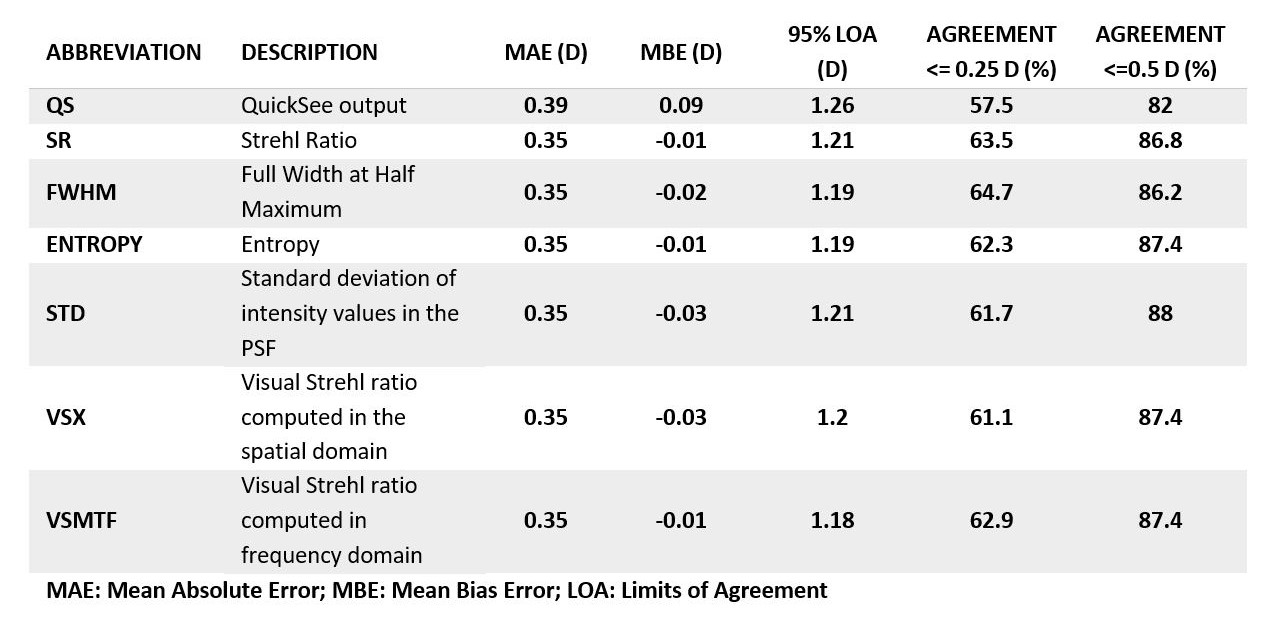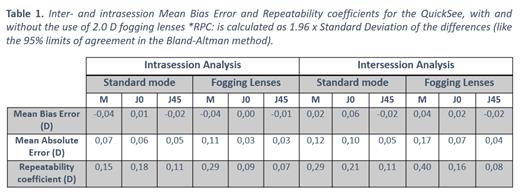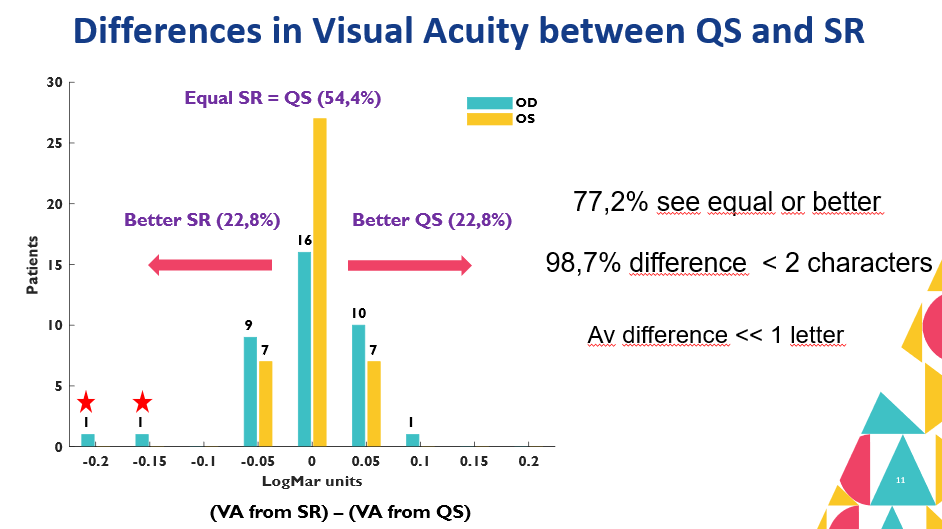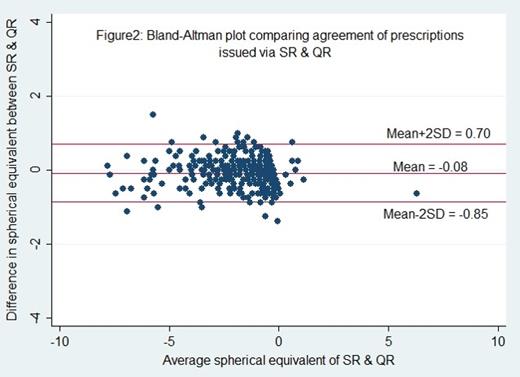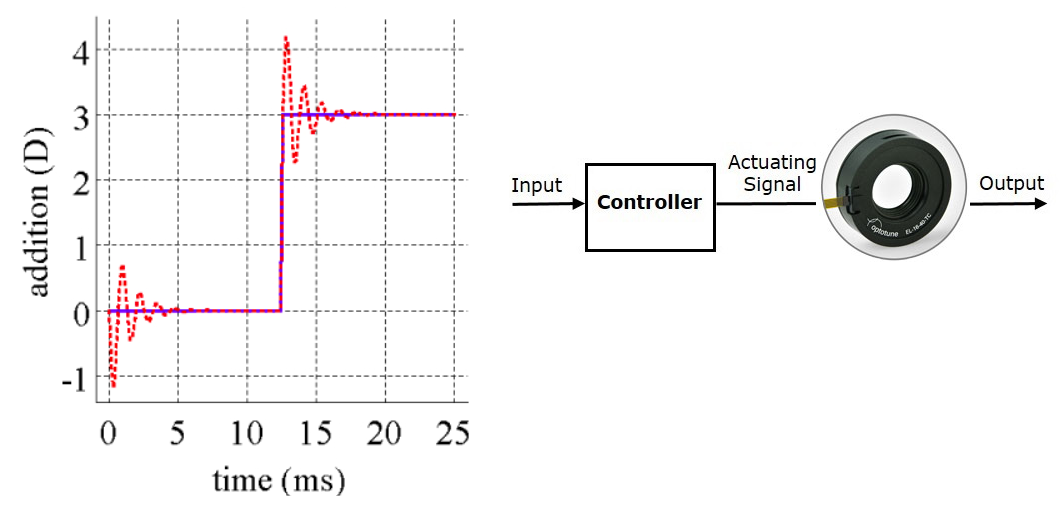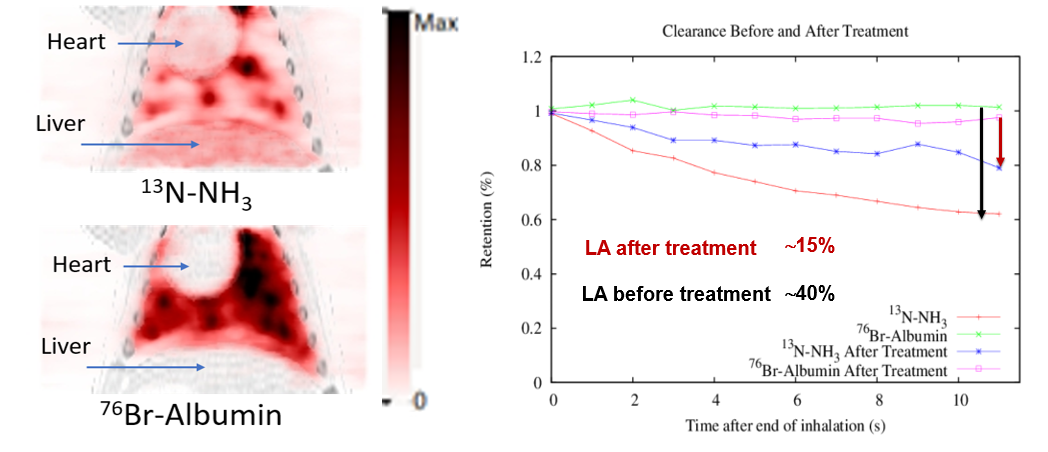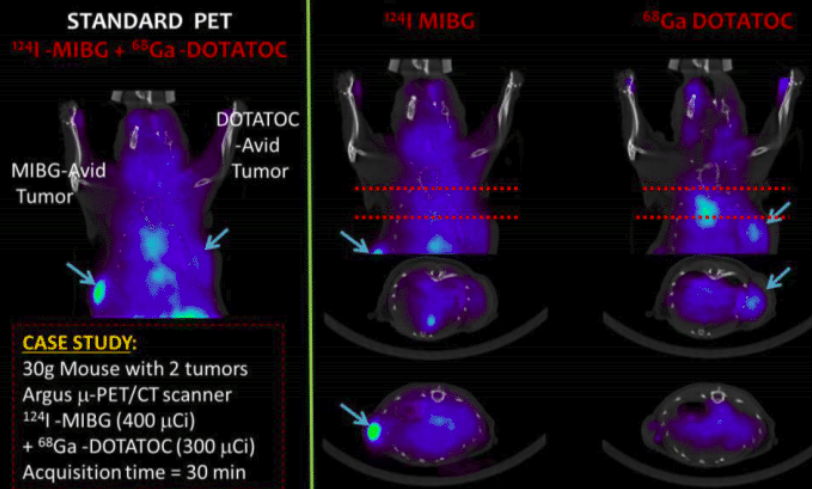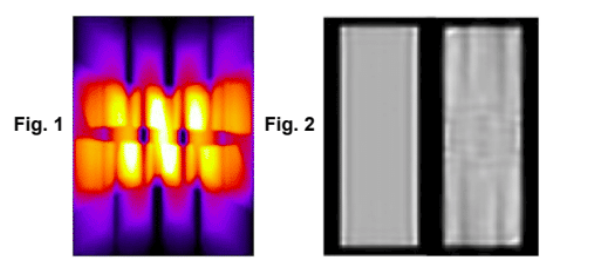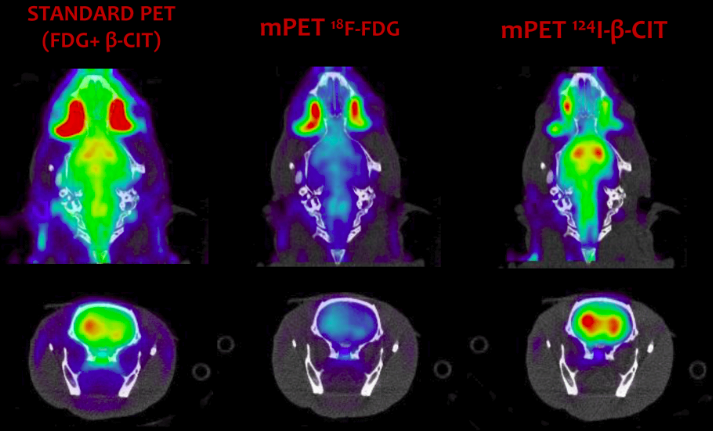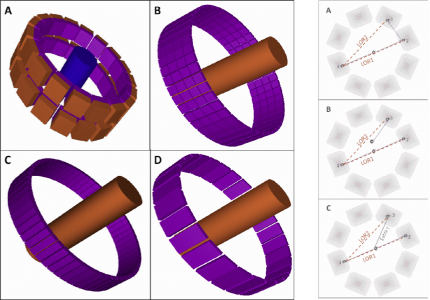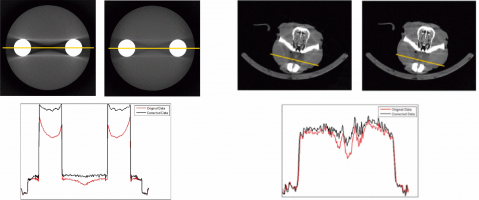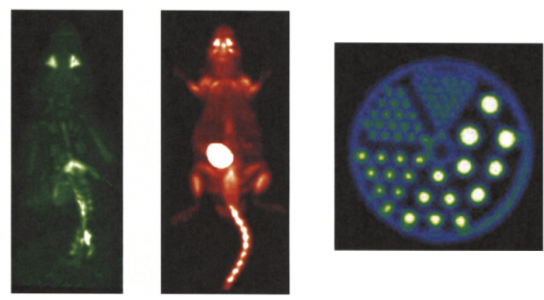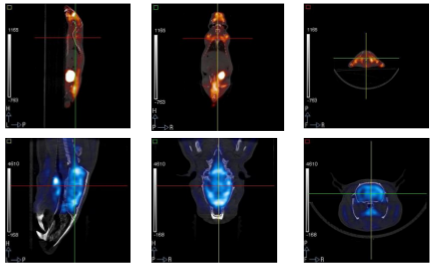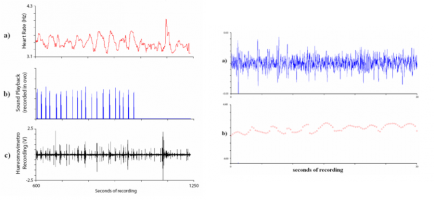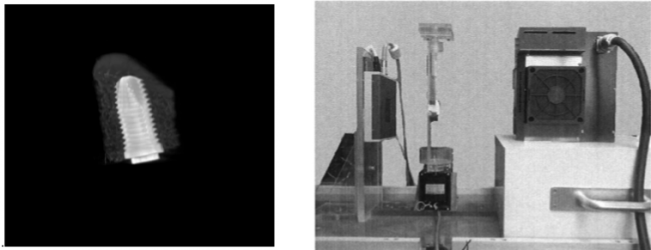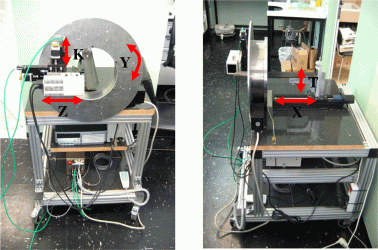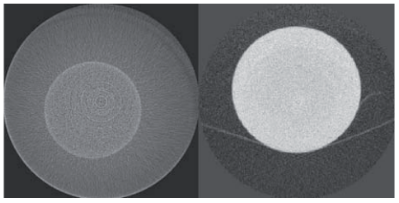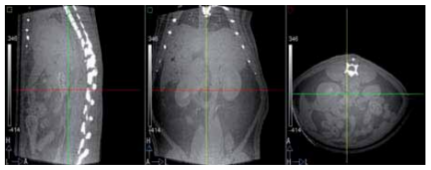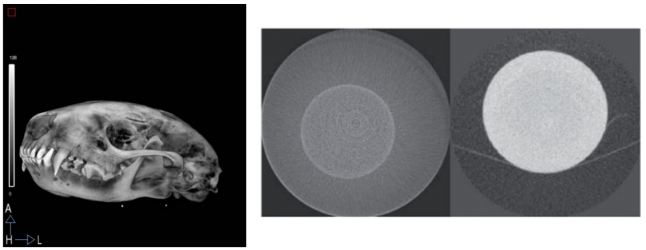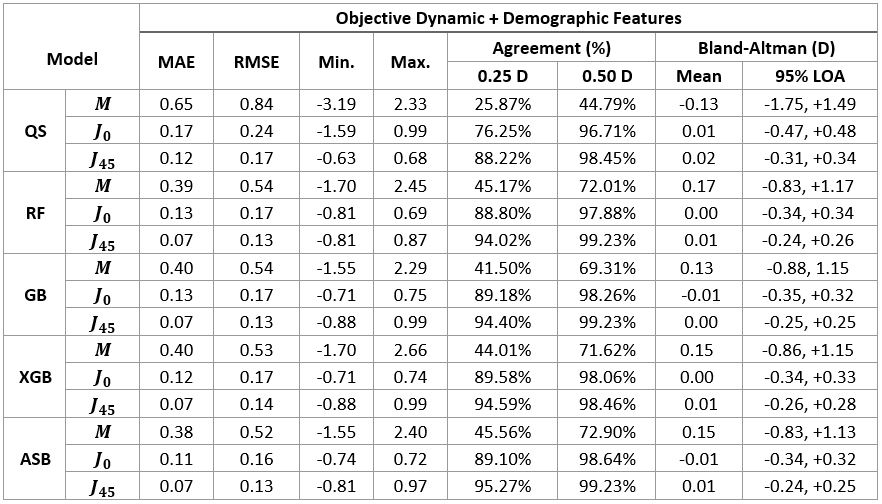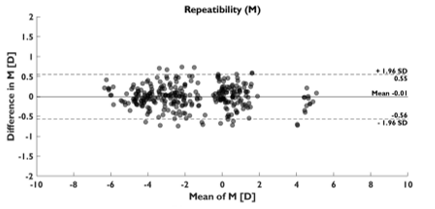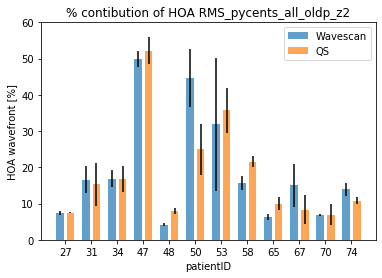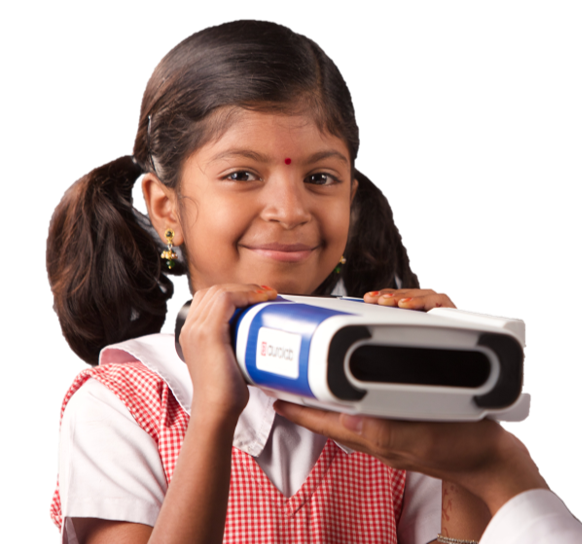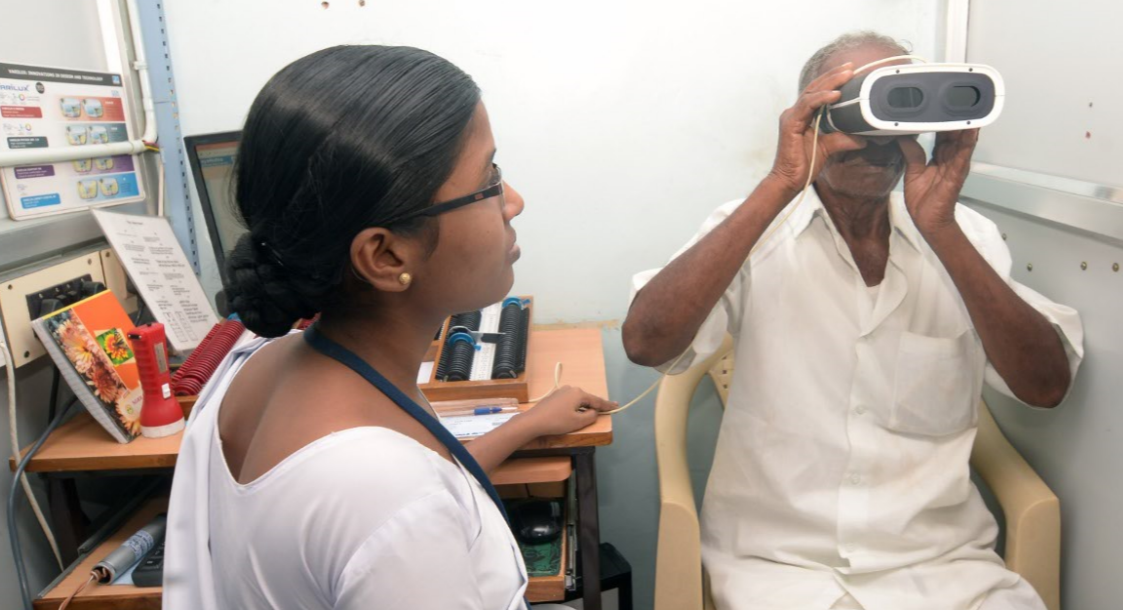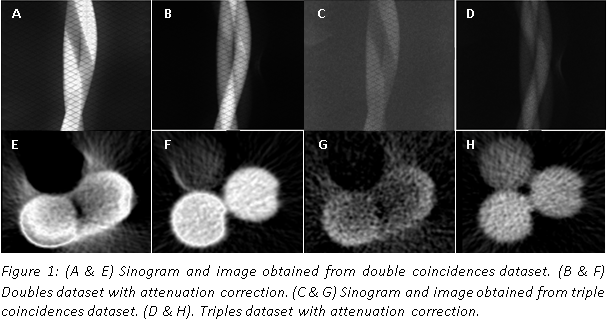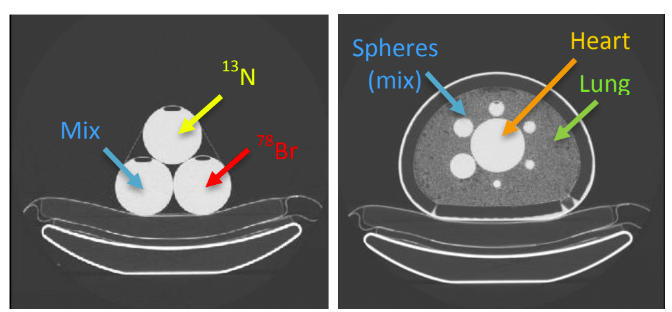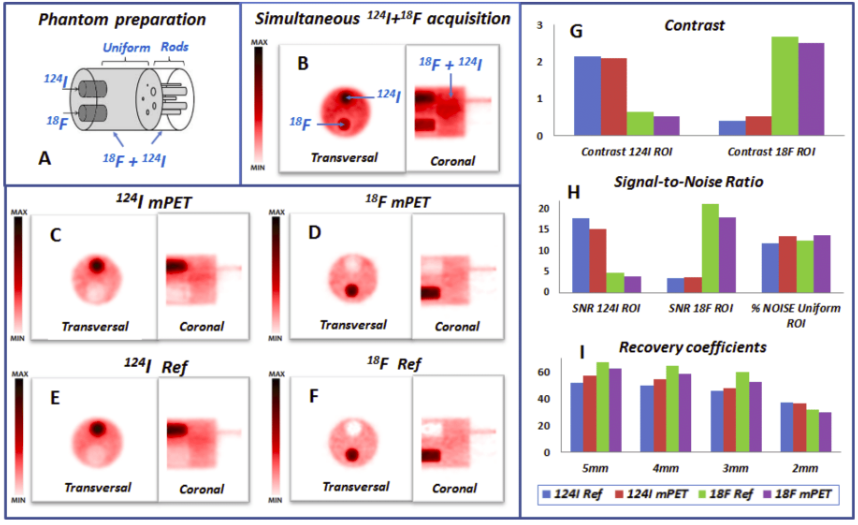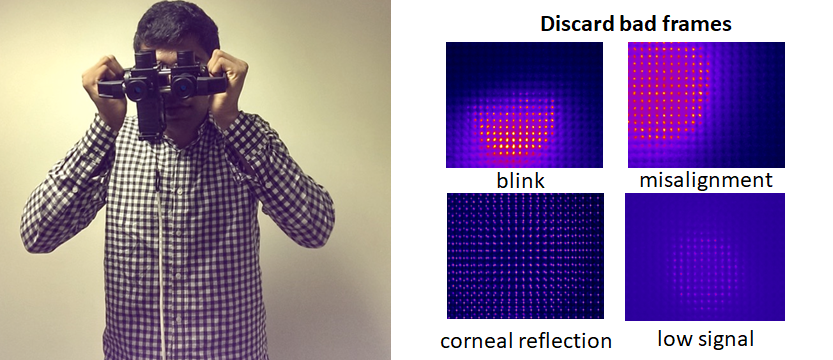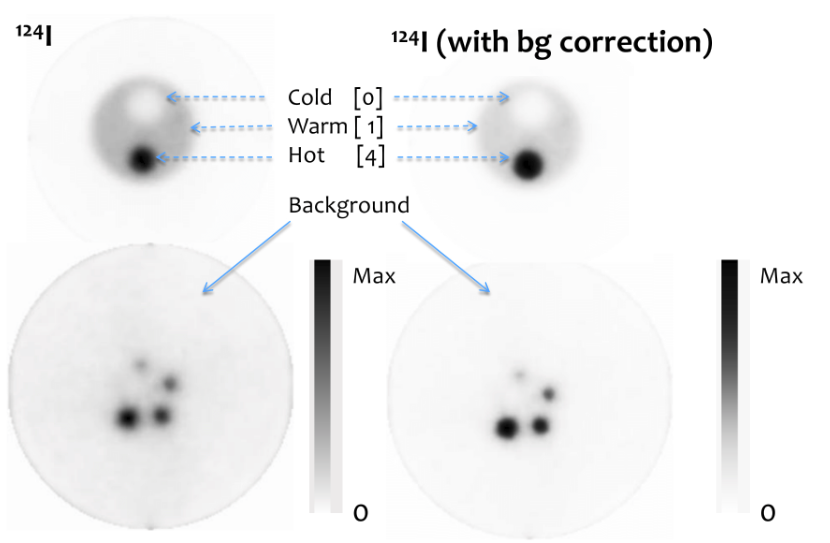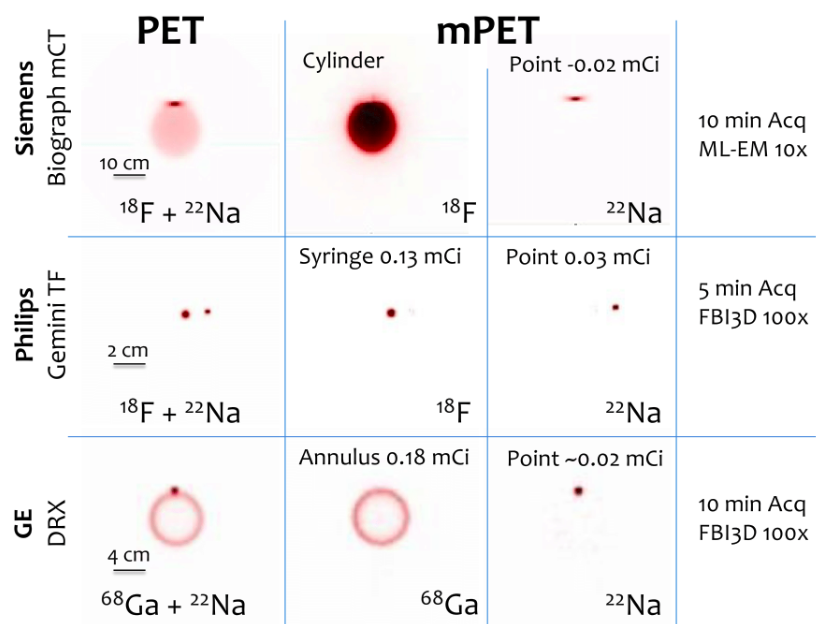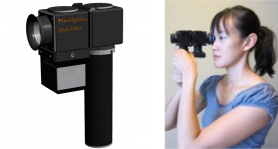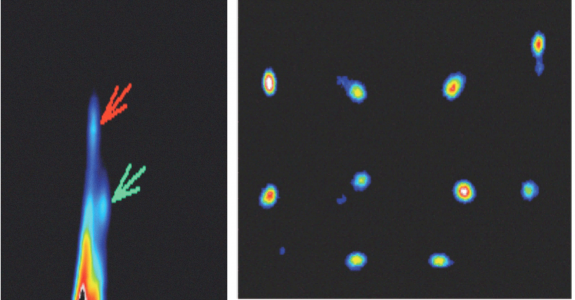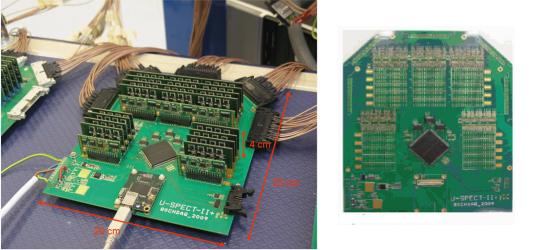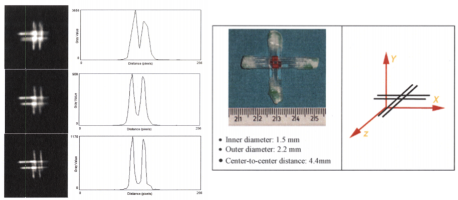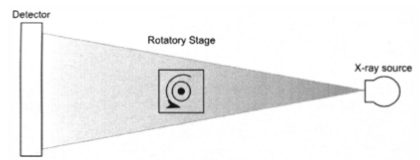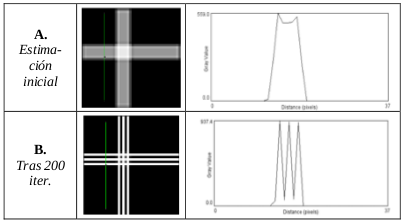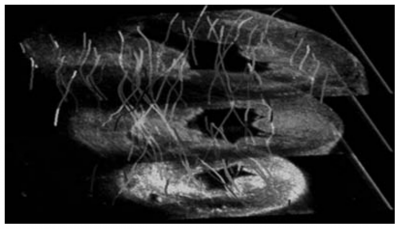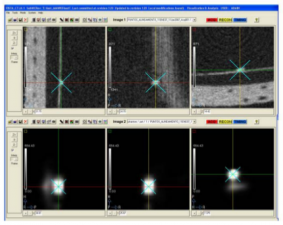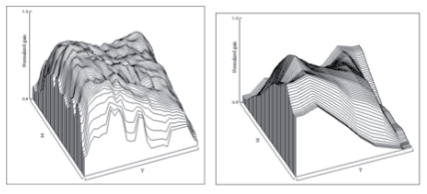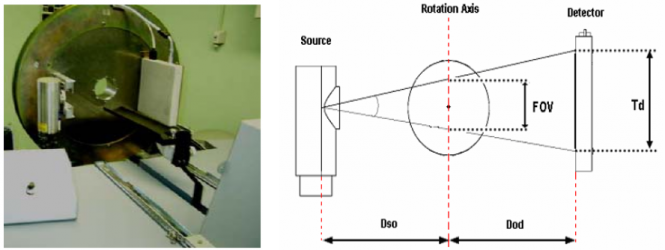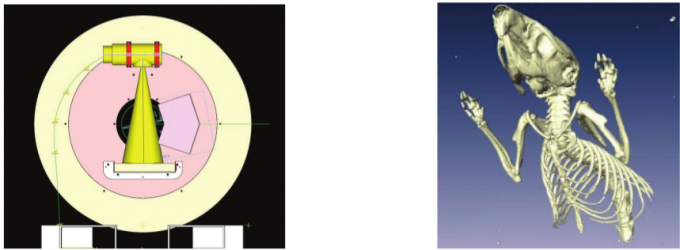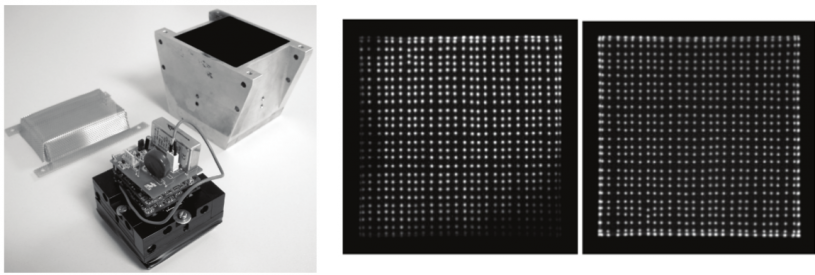| AUTHORS | |
| JOURNAL | ARVO |
| ABSTRACT |
PurposeModern autorefractors have demonstrated high accuracy and higher repeatability than manifest refraction in adults yet are not considered precise enough to substitute the gold standard, even in low-resource settings where there is a severe shortage of experienced refractionists. This work evaluates a novel approach that combines dynamic wavefront aberrometry data, acquired using an affordable portable autorefractor, with the analysis of retinal image quality metrics (IQMs) to predict subjective refraction. Methods56 subjects (34±14 years) were recruited for the analysis. Each participant underwent standard clinical refraction followed by a 10-second video acquisition using a QuickSee (QS) wavefront aberrometer (PlenOptika, USA). Shack-Hartmann images of each video for the right eye were processed to obtain Zernike coefficients up to the 4th order. Coefficients obtained for each image were mathematically corrected with the closest sphero-cylindrical correction and the residual wavefront error was used to calculate the Point Spread Function (PSF) and IQMs (e.g., Strehl Ratio) describing some performance parameter of the corrected eye. Since each IQM is part of a dynamic sequence, it is possible to build a dynamic signal for each metric which contains information about fluctuations in image quality during the measurement. The final refraction is obtained as the average of the refractions corresponding to the images whose IMQs provided optimal performance. ResultsThe proposed method reduced the differences between QS and manifest refraction. Specifically, for spherical equivalent refraction (M) (Table 1) a 79% average reduction in MBE together with moderate average improvements for MAE (10.3%), LOA (5%), and percentage of agreement within 0.25D (8.8%) and 0.5D (6.3%) were found for all IQMs evaluated. ConclusionsThe proposed algorithm behaves as an efficient filter which selects those measurements within the dynamic sequence that are more representative of the manifest refraction of the patient. |
| LINK | here |
| AUTHORS |
Eduardo Lage
Carlos Santiago Hernandez
Andrea Gil Ruiz
Ignacio Casares
Jesus Poderoso
Alec Wehse
Alfonso de Lara
Daryl Lim
Shivang Dave
|
| JOURNAL | ARVO |
| ABSTRACT |
PurposeHigh repeatability portable autorefractors may enable effective deploy of global-health initiatives to mitigate uncorrected refractive error worldwide. For example, in studies to evaluate the effectiveness of different measures, repeatability has a direct impact on the statistical power and sample size required, while in screening applications, contributes to increased sensitivity and specificity. This work presents a preliminary assessment of the inter- and intrasession repeatability of an affordable autorefractor (QuickSee, PlenOptika Inc) under two separate measurement conditions, with and without fogging lenses. Methods6 volunteers (29,8 ± 8,1 years old) were measured at 2 different sessions spaced 1-week. Each subject was tested 6 times per session with the QuickSee, 3 times in standard mode and 3 using a modified version of the device eyecup to allow over-refraction through fogging lenses (+2.0 D). Intersession measurements were spaced 5 minutes apart and the complete alignment procedure was repeated for each measurement. After converting autorefractor readings into power vectors (M, J0, J45), repeatability was evaluated using the Bland-Altman method to compare differences between all possible combinations from each subject (inter- and intrasession). Repeatability coefficients (RPC), estimated as the 95% limits of agreement, and the mean absolute errors were also evaluated. In all cases, only results for the right eyes were analyzed. ResultsParticipants had an average Spherical Equivalent (SE) refraction of -0.75 ± 2.06 D, (Min -5.11 D, Max 0.175 D). A total of 36 samples per dataset were obtained for the intrasession analysis while 54 samples per dataset were used in the intersession comparison. In all cases the mean difference was practically 0 indicating no bias for any of the vector components. SE RPCs for intrasession test were 0.15 D in standard mode and 0.29 D with the fogging lenses. Intersession RPCs were 0.29 D and 0.4 D without and with the fogging lenses, respectively. Detailed results for all vector components are shown in Table 1. ConclusionsThis preliminary analysis shows that the device can provide excellent RPCs in standard mode, which decrease moderately with the use of the fogging lenses. Further work exploring improvements in the eyecup design and measurement averaging techniques may further enhance the RPC values in over-refraction mode. |
| LINK | here |
| AUTHORS |
Nuria Estebanez
Andrea Gil
Eduardo Lage
Nicolas Alejandre-Alba
|
| Conference | 39th Congress of the ESCRS (European Society of cataract and refractive Surgeons), Amsterdam 2021 |
|
Purpose : To evaluate a novel open-binocular low-cost handheld device (QuickSee), for measuring refractive errors in post cataract surgery patients. |
| AUTHORS |
Sanil Joseph
David S. Friedman
Thulasiraj Ravilla
Shivang R. Dave
Eduardo Lage
Varshini Varadaraj
Kanza Aziz
|
| JOURNAL | Investigative Ophthalmology & Visual Science June 2020, Vol.61, (ARVO 2020) |
|
Purpose : In low-resource settings with large burden of uncorrected refractive errors, auto-refractors are conventionally considered too expensive and inaccurate to significantly improve refractive eye care. We compared patient acceptance of eyeglasses prescribed using a low-cost, portable auto-refractor (the QuickSee) with that of eyeglasses prescribed via standard subjective refraction. We also compared the accuracy of the QuickSee refraction measurements with subjective refraction performed by trained technicians at Aravind Eye Hospital (AEH), India. |
| AUTHORS |
Carlos Dorronsoro
Victor Rodriguez-Lopez
Xoana Barcala
Enrique Gambra
Vyas Akondi
Lucie Sawides
Yassine Marrakchi
Eduardo Lage
Wilso S Geisler
Susana Marcos
|
| JOURNAL | Investigative Ophthalmology & Visual Science July 2019, Vol.60, 6465 (ARVO 2019) |
|
Purpose : Recent simultaneous vision simulators (SimVis) rely on the principle of temporal multiplexing of optotunable lenses (TL): Image components from different foci are superimposed to match the thru-focus optical quality of specific multifocal patterns. If sufficiently fast, the retinal images appear static. The temporal physical and perceptual aspects of temporal multiplexing are experimentally evaluated. |
| AUTHORS |
M Tamayo
L Martin
MJ Garcia-Piedra
E Lage
A Val-Blasco
M Fernandez-Velasco
C Delgado
|
| JOURNAL | 2018 International congress on vitamin D, Barcelona Spain |
| Heart failure (HF) is a major cause of morbidity and mortality. In various forms of HF, excessive cardiac workload leads to enlargement of the heart in an effort to manage increased hemodynamic demand. Although the increased heart size is a compensatory mechanism, sustained overload can ultimately lead to ventricular dilatation and a decline in left ventricular (LV) function. Furthermore, several K+ currents are down regulated during adverse ventricular remodelling, contributing to repolarization abnormalities and the occurrence of ventricular malignant arrhythmias. |
| AUTHORS |
J. Venegas
J.L. Herraiz
M. Papisov
E. Lage
A. Santos
M.A. Lessa
S. Weise
C. Kososur
|
| JOURNAL | American Thoracic Society Conference 2017, Washington, USA |
| ABSTRACT |
Rationale: Cystic fibrosis (CF), is a disease characterized by airway liquid surface dysregulation, decreased depth of
|
| AUTHORS |
J. F. P. J. Abascal
Eduardo Lage
J.L. Herraiz
M. E. Martino
M. Desco
J. J. Vaquero
|
| JOURNAL | IEEE Nuclear Science Symposium & Medical Imaging conference |
| ABSTRACT |
In this work, we propose a novel 4D reconstruction method for PET which is based on spatiotemporal total variation (ST-TV). The ST-TV method takes advantage of image redundancies in 4D and was efficiently implemented using the split Bregman formulation, which has been shown to be optimal for decreasing noise while maintaining image quality. To evaluate the proposed approach we simulated data for a dynamic numerical phantom with different number of counts to mimic high and low Signal-to-Noise Ratio (SNR) scenarios.
|
| AUTHORS |
Joaquin L. Herraiz
Stephen C. Moore
Jose M. Udias
Santiago Peña-Zalbidea
Mi-Ae Park
Marisa SotoMontenegro Juan Jose Vaquero
Francisca Mulero
Eduardo Lage
|
| JOURNAL | European Molecular Imaging Meeting-EMIM, 2016 |
| ABSTRACT | Introduction: Simultaneous in-vivo imaging of several biological processes may improve oncological, neurological and cardiovascular studies by providing complementary information obtained under the same exact conditions and coregistered in space and time. Standard PET imaging does not allow multiplexed acquisitions, as all annihilation photons have the same energy. We developed a technique called multiplexed PET (mPET), which uses a tracer labelled with a pure positron emitter (such as 18 F, 13 N, 11 C), and a tracer labeled with a positrongamma emitter (such as 124 I, 76 Br, 82 Rb, 86 Y). Positrongamma emitters generate a significant number of triplecoincidences , which allows them to be differentiated from the standard PET radionuclides . In this work, we evaluated the performance of mPET using phantom and animal experiments. |
| AUTHORS |
S. C. Moore
M. Cervo
S. D. Metzler
E. Lage
J. M. Udias
J. L. Herraiz
|
| JOURNAL | IEEE Nuclear Science Symposium & Medical Imaging Conference, 2015 |
| ABSTRACT | When multiple pinholes are used to acquire SPECT projection data, there may be regions on the detectors where data from two or more pinholes overlap. Such “multiplexing” of projection data can cause artifacts and/or increased noise in reconstructed SPECT images, depending on the exact acquisition geometry. We previously described a modified MLEM algorithm that alternates between (i) estimating the separated projection data that would be obtained through each individual pinhole (i.e., demultiplexed data), based on the current MLEM iteration’s image, and (ii) reconstructing the SPECT image by MLEM, but assuming that the demultiplexed data estimates are the actual measured data. The modified MLEM algorithm was first tested with data simulated for a stationary 39pinhole collimator tube, and more recently with Tc99m phantom data acquired from three vials of different sizes on a 6pinhole, tripledetector SPECT camera. |
| AUTHORS |
V. Parot
J. L. Herraiz
S. R. Dave
J. M. Udias
S. C. Moore
M.A. Park
J. J. Vaquero
E. Lage
|
| JOURNAL | IEEE Nuclear Science Symposium & Medical Imaging Conference, 2014 |
| ABSTRACT | Simultaneous noninvasive evaluation of biological processes can improve molecular imaging by providing complementary tissue functions under equivalent conditions coregistered in space and time. Positron Emission Tomography (PET) is the most sensitive noninvasive molecular imaging tool, able to measure many physiological properties with a number of radiotracers. Unfortunately, positron annihilation gamma rays are identical for all radiotracers, making them indistinguishable with standard PET imaging. This fact has motivated attempts at dual tracer imaging with standard PET to distinguish radiotracers using timebased differences. |
| AUTHORS |
J. F. P. J. Abascal
E. Lage
M. E. Martino
J. L. Herraiz
M. Desco
J. J. Vaquero
|
| JOURNAL | IEEE Nuclear Science Symposium & Medical Imaging Conference, 2014 |
| ABSTRACT | Dynamic PET images suffer from low signaltonoise ratio (SNR), especially for fast contrast uptake measurements due to the small number of counts available in those time frames. In this work, we propose a 4D reconstruction method based on spatiotemporal total variation (STTV) which takes advantage of image redundancies in 4D. The 4D STTV method was efficiently implemented using the Split Bregman formulation, which has been shown to be optimal for decreasing noise while maintaining image quality. To evaluate the proposed approach we acquired listmode data from a NEMA image quality phantom in a preclinical PET/CT scanner. |
| AUTHORS |
J. López Herranz
F. Mulero Aniorte
V. Parot
S. Dave
S. Moore
J.M. Udias
J.J. Vaquero
E. Lage
|
| JOURNAL | Revista Española de Medicina Nuclear e Imagen Molecular, Vol. 33, Supl. 1, 2014 |
| ABSTRACT | Objetivo: La PET es la modalidad de imagen con mejores prestaciones para la obtención de información funcional y molecular in vivo. Sin embargo, esta técnica no permite la utilización de más de un radiotrazador de forma simultánea debido a que las señales emitidas por los radionúclidos utilizados para el marcaje son indistinguibles entre sí. En este trabajo se introduce una nueva metodología (mPET) que permite la adquisición y separación de las imágenes de al menos dos trazadores en escáneres PET convencionales. |
| AUTHORS |
J. L. Herraiz
E. Lage
V. Parot
S.R. Dave
J.M. Udias
J.J. Vaquero
A. Muñoz-Martin
L.M. Fraile
|
| JOURNAL | IEEE Nuclear Science Symposium Conference Record, 2013 |
| ABSTRACT | The metal radionuclides 60Cu (T1/2 = 23 min), 52mMn (T1/2 = 21 min) and 94mTc (T1/2 = 53 min) can be used to label tracers of high clinical and preclinical interest in PET studies. Furthermore, as they emit prompt gamma-rays right after the positron emission, they can be distinguished from standard positron emitters like 18F, enabling multiplexed PET (mPET) imaging. In this work we studied the feasibility of their production using a relatively low-energy (10 MeV) proton beam from a linear accelerator. |
| AUTHORS |
J. Cal-González
E. Herranz
E. Vicente
J.M. Udías
S. R. Dave V. Parot
E. Lage
J.L. Herraiz
|
| JOURNAL | IEEE Nuclear Science Symposium Conference Record, 2013 |
| ABSTRACT | Most PET scanners are designed to detect and record gamma-ray coincidences from the annihilation of positrons coming from radiotracers. Multiple coincidences, those for which more than two gamma-rays are detected within the coincidence time window, are usually discarded. Those events can be registered and used to increase the sensitivity of the scanner and to differentiate positron-gamma emitters from pure positron emitters, enabling multiplexed PET. To assess the effect of triple coincidences in PET scanners, an accurate and reliable simulation toolkit is compulsory. In this work we extend and validate the Monte Carlo (MC) simulator PeneloPET to deal with multiple-coincidences in PET scanners. |
| AUTHORS |
A. Sisniega
M. Abella
E. Lage
M. Desco
J.J. Vaquero
|
| JOURNAL | IEEE Nuclear Science Symposium Conference Record, 2012 |
| ABSTRACT |
Scattered photons highly degrade the quality of X-ray images and their effect has become more important due to the increasing interest in cone-beam geometry for the acquisition of CT (CBCT) and micro-CT data. The random nature of scatter events and the great influence of the sample suggest that the most accurate methods for their estimation are Monte Carlo (MC) techniques, but their use is usually hampered by the large computation time required to obtain an acceptable estimation of the scattered radiation. We present an approach for scatter correction in CBCT by MC estimation, speeding up the computation by means of general purpose graphic processing units (GPGPU) and developing a framework for the automatic correction and reconstruction of projection data.
|
| AUTHORS |
A. Olmo
G. Zamora
C. García-Villalba
V. García-Vázquez
M. Abella
E. Lage
M. Desco
J.J. Vaquero
|
| JOURNAL | XXIX Congreso Anual de la Sociedad Española de Ingeniería Biomédica, 2011 |
| ABSTRACT |
En este trabajo se presenta la interfaz de usuario de un nuevo escáner SPECT para animales de laboratorio. Se trata de una herramienta versátil, diseñada para facilitar la interacción del usuario con los diferentes subsistemas del tomógrafo. Esta herramienta permite llevar a cabo la calibración del aparato, la adquisición de estudios SPECT, y la reconstrucción de las imágenes correspondientes a los mismos. En este trabajo se presenta la versión inicial de esta herramienta, y las pruebas realizadas para la validación de la misma.
|
| LINK | https://e-archivo.uc3m.es/handle/10016/20857 |
| AUTHORS |
A. Sisniega
M. Abella
E. Lage
M. Desco
J.J. Vaquero
|
| JOURNAL | XXVIII Congreso Anual de la Sociedad Española de Ingeniería Biomédica, 2010 |
| ABSTRACT |
La calidad de imagen obtenida por equipos micro-TAC (tomografía axial computarizada) para pequeño animal depende en gran medida de la bondad del calibrado de los mismos. En la literatura previa se han propuesto diferentes métodos para el calibrado de cada uno de los parámetros de un sistema micro-TAC. Sin embargo, existen pocas referencias sobre el esquema de calibración global a seguir para obtener los mejores resultados. En este trabajo se presenta una propuesta para el calibrado global de equipos micro-TAC, que ordena los pasos del proceso y elimina posibles interdependencias entre los mismos.
|
| AUTHORS |
Alejandro Sisniega
Juan J. Vaquero
Monica Abella
Irina Vidal Migallón
Eduardo Lage
Manuel Deseo
|
| JOURNAL | IEEE Nuclear Science Symposium Conference Record, 2009 |
| ABSTRACT |
This work presents an approach to extend the dynamic range of X-ray flat-panel detectors for cone-beam micro-CT by using two different acquisitions of the same sample, taken at two different X-ray photon fluxes with the same X-ray beam peak energy and filtration. Photon flux for the first scan is chosen as the maximum possible value not saturating the detector in the low attenuation areas. The second exposure level is calculated from the data acquired in the first exposure, assuming that the detector response to the incoming radiation is linear. |
| AUTHORS |
E. Lage
J. Villena
G. Tapias
I. Vidal-Migallón
M. Abella
A. Sisniega
J. Pavía
D. Ros
M. Desco
J. J. Vaquero
|
| JOURNAL | XXVII Congreso Anual de la Sociedad Española de Ingeniería Biomédica, 2009 |
| ABSTRACT |
rSPECT es un nuevo escáner SPECT para animales de laboratorio compuesto por dos gamma-cámaras de elevado rendimiento y tamaño reducido. El diseño de las cámaras, basado en cristales pixelados y tubos fotomultiplicadores, permite el uso de diferentes colimadores en función de los requerimientos del estudio.
|
| AUTHORS |
Mario Cafiadas
Miguel Embid
Eduardo Lage
Manuel Desco
Juan Jose Vaquero
Jose Manuel Perez
|
| JOURNAL | IEEE Nuclear Science Symposium Conference Record, 2008 |
| ABSTRACT |
It is usually difficult to compare different designs of Positron Emission Tomography (PET) small-animal scanners because of the disparity of measurements protocols. In this work we compare two commercial PET scanners installed at CIEMAT (Madrid, Spain): the ClearPET and the rPET-1, using an assessment procedure that fulfilled the recommendations of the new NEMA NU 4-2008 standard to evaluate small animal PET systems, including spatial resolution, sensitivity, scatter fraction and count losses studies. |
| AUTHORS |
Eduardo Lage
Juan Jose Vaquero
Alejandro Sisniega
Samuel Espana
Gustavo Tapias
Angel Udias Veronica Garcia
Alexia Rodriguez-Ruano
Manuel Desco
|
| JOURNAL | IEEE Nuclear Science Symposium Conference Record, 2008 |
| ABSTRACT |
This work reports on the development and evaluation of the PET component of a PET/CT system for small-animal in-vivo imaging. The PET and CT subsystems are assembled in a rotary gantry in such a way that the center of rotation for both imaging modalities is mechanically aligned. The PET scanner configuration is based on 2 detector modules, each of which consist of 2 flat-panel type PS-PMTs (Hamamatsu, H8500) and 2 (30 × 30 elements) LYSO arrays.
|
| AUTHORS |
E. Lage
J. J. Vaquero
A. Sisniega
S. España
G. Tapias
A. Udías
V. Garcia
A. Rodríguez-Ruano
M. Desco
|
| JOURNAL | XXVI Congreso Anual de la Sociedad Española de Ingeniería Biomédica, Oct. 2008 |
| ABSTRACT |
Este trabajo describe el proceso de desarrollo y la evaluación inicial de un nuevo sistema tomográfico PET/CT de alta resolución, enfocado a la realización de estudios preclínicos “in-vivo” con animales de laboratorio. En el diseño implementado, los centros geométricos de cada modalidad de imagen están alineados mecánicamente permitiendo la obtención de conjuntos de datos con información anatómica y funcional que se registran y fusionan de forma automática.
|
| AUTHORS |
G. Tapias
I. Vidal Migallón
E. Balaban
J.J. Vaquero
E. Lage
A. Sisniega
M. Desco
|
| JOURNAL | XXIV Congreso Anual de la Sociedad Española de Ingeniería Biomédica, Oct. 2008 |
| ABSTRACT |
En el ámbito de la investigación con huevos aviares, resulta útil la observación del pulso cardiaco y los movimientos del embrión dentro del huevo durante su incubación, ya sean parte de su desarrollo o respuesta a estímulos sensoriales. El sistema presentado es un balistocardiógrafo de alta sensibilidad y bajo coste, implementado mediante cápsulas fonográficas. El sistema permite monitorizar de forma constante y no invasiva la señal correspondiente al pulso cardiaco y los movimientos del embrión dentro del huevo en desarrollo.
|
| AUTHORS |
A. Sisniega
E. Lage
A. de Carlos
J. Villena
M. Abella
I. Vidal
G. Tapias
J.C. Antoranz
M. Desco
J.J. Vaquero
|
| JOURNAL | XXVI Congreso Anual de la Sociedad Española de Ingeniería Biomédica, Oct. 2008 |
| ABSTRACT |
El objetivo de este trabajo es la comparación de dos detectores de rayos X tipo “flat-panel” (C7940DK-02, C9321SK-05, Hamamatsu Photonics), para su uso en TAC de haz cónico de alta velocidad para pequeños animales. |
| AUTHORS |
E Lage
JJ Vaquero
J Villena
A de Carlos
G Tapias
A Sisniega
M Desco
|
| JOURNAL | IEEE Nuclear Science Symposium Conference Record, 2007 |
| ABSTRACT |
In this work we characterized a recently developed gamma imager for small animal SPECT applications. The Hamamatsu C9177 is a mini-gamma camera that integrates the detector and all the electronics, including the acquisition system, in a compact and portable housing. The detector is based on a high resolution parallel hole collimator, a CsI(NaI) crystal array and a PS-PMT (flat panel type). |
| AUTHORS |
A. Sisniega
J.J. Vaquero
E. Lage
M. Abella
A. Rodríguez
V. García
A. Udías
J. Pascau
M.L. Soto-Montenegro
E. Vicente
M. Desco
|
| JOURNAL | XXV Congreso Anual de la Sociedad Española de Ingeniería Biomédica, Enero 2007 |
| ABSTRACT |
En este artículo se describe la implementación de un sistema PET/CT basado en un ‘gantry’ común. El subsistema de detección PET está formado por dos detectores enfrentados compuestos cada uno de ellos por dos matrices de cristales de centelleo (MLS) y dos tubos fotomultiplicadores sensibles a posición (H8500). El subsistema CT comprende una fuente micro-focal de rayos X junto con un detector formado por elementos semiconductores. Los elementos que forman el escáner CT, así como los detectores enfrentados del sistema PET han sido situados en el mismo plano, de tal forma que los centros axial y trans-axial son compartidos por ambos sistemas. Para evitar contaminación y ruido en la adquisición, los detectores han sido rodeados con elementos de blindaje.
|
| AUTHORS |
L. Conejero
M.L. Soto
J.J. Vaquero
M.L. Baeza
E. Lage
I. Varela-Nieto
M. Desco
J.M. Zubeldia
|
| JOURNAL | The Journal of Allergy and Clinical Immunology, Volume 119, Issue 1, January 2007 |
| ABSTRACT |
RATIONALE: Intranasal administration is one of the main routes of allergen challenge in mouse models of airway disease. Although it is widely used, it is not well established the amount of allergen that reaches the lung or is lost to the gastrointestinal tract. The local distribution of the challenge solution within the airways is also unknown. The aim of this study was to assess the distribution immediately after intranasal delivery using a Positron Emission Tomography scanner (PET). |
| AUTHORS |
G.Tapias
J.J. Vaquero
E. Lage
M. Abella
S. Redondo
M. Desco
A. Udias
|
| JOURNAL | XXIV Congreso Anual de la Sociedad Española de Ingeniería Biomédica, Noviembre 2006 |
| ABSTRACT |
Se presenta la caracterización inicial de un tomógrafo volumétrico de rayos-X (VCT) diseñado para un campo de visión de 7,5 cm. Para caracterizar el sistema se ha evaluado la estabilidad y la función de transferencia (MTF) del detector, la resolución del sistema, la calidad de las imágenes reconstruidas y la dosis irradiada a la muestra en los estudios. La medida de la resolución del sistema siguió el estándar ASTM E1696-95. La calidad de las imágenes se ha evaluado mediante la relación señal a ruido (SNR) y la relación contraste frente a ruido (CNR), ambas medidas en función de la dosis radiada sobre imágenes calibradas en unidades Hounsfield.
|
Diseño y desarrollo de un sistema micro-CT de alto rendimiento para pequeños animales de laboratorio
| AUTHORS |
E. Lage
J.J. Vaquero
S. Redondo
M. Abella
G. Tapias
A. Udías
M. Desco
|
| JOURNAL | XXIV Congreso Anual de la Sociedad Española de Ingeniería Biomédica, Noviembre 2006 |
| ABSTRACT |
Se describe la implementación de un escáner micro-CT adecuado para ser utilizado como elemento complementario en
diferentes escáneres PET para pequeños animales. El diseño básico del sistema se basa en el montaje de un tubo micro-foco de rayos-X y un detector digital plano sobre un soporte rotatorio.
|
| AUTHORS |
S. Redondo
J. J. Vaquero
E. Lage
M. Abella
G. Tapias
A. Udias
M. Desco
|
| JOURNAL | IEEE Nuclear Science Symposium Conference Record, 2006 |
| ABSTRACT |
We have developed an X-ray cone beam tomograph for in vivo small-animal imaging using a flat panel detector (CMOS technology with a columnar CsI scintillator plate) and a microfocus X-ray source in a geometric configuration with 1.6 magnification and 7.5 cm2 field of view. This work presents an initial characterization of this new system. We measured the detector modulation transfer function (MTF), detector stability, system resolution, the quality of the reconstructed tomographic images and radiated dose.
|
| AUTHORS |
J. Vaquero
E. Lage
S. Redondo
M. Abella
E. Vicente
M. Desco
|
| JOURNAL | Molecular Imaging and Biology, Vol. 8, No. 2, 2006 |
| ABSTRACT |
In this work we report initial results from a prototype of a small-animal positron emission tomography (PET)/ computed tomography (CT) system based on a common rotating gantry. The PET system consists of two detector modules based on MLS arrays and four large-area, flat-panel type PS-PMTs. The CT scanner uses a micro-focus X-ray tube and a semiconductor X-ray detector in a cone-beam geometry. Space for opposed PET detectors and the CT scanner has been allocated on the same face of the gantry disk, thus achieving a co-planar geometry that perfectly aligns the trans-axial and axial centers for both image modality systems. Shields around the detectors reduce cross modality contamination due to scatter in the sample when it is illuminated by the X-ray source.
|
| AUTHORS |
Javier Sánchez-González
Samuel España
Mónica Abella
Juan José Vaquero
Eduardo Lage
Javier Pascau
Manuel Desco
|
| JOURNAL | IEEE Nuclear Science Symposium Conference Record, 2005 |
| ABSTRACT |
A new reconstruction strategy is proposed for 3D images acquired with rotating PET scanners. This method is based on the decomposition of the system response matrix (SRM) into a projection and a rotation components that are inverted independently. We present the rationale of the new reconstruction procedure as well as some examples to compare with analytical 3D reconstruction (3DRP) and 3D statistical reconstruction (3D-OSEM).
|
| LINK | http://ieeexplore.ieee.org/document/1596894/ |
| AUTHORS |
M. L. Soto-Montenegro
J. J. Vaquero
L. Ricon
E. Lage
V. Verdugo
M. Desco
|
| JOURNAL | Molecular Imaging and Biology, Vol. 7, No. 2, 2005 |
| ABSTRACT |
Introduction: The search of oncologic lesions in thorax may be hindered by the high uptake of organs such as the heart or back muscles that prevent the proper visualization of neighbor organs. The aim of this study is to analyze to what extent glucose metabolism can be modulated to obtain an optimal thorax image in mice. |
| AUTHORS |
Carlos Santiago Hernandez Torres
Andrea Gil Ruiz
Ignacio Casares
Jesus Poderoso
Alec Wehse
Shivang Dave
Daryl Lim
Manuel Sánchez Montañés
Eduardo Lage Negro
|
| JOURNAL | ARVO |
| ABSTRACT |
PurposeUncorrected Refractive Errors (UREs) is a reversible condition that can be treated with appropriate eyeglasses. UREs affect over 1 billion people globally, with 90% of this population living in low-and-middle-income countries where vision exams can be highly inaccessible due to a shortage of experienced eyecare professionals. This work aims to assess if a machine learning (ML) approach, when applied to data obtained with an affordable handheld autorefractor, could increase access to clinical-quality subjective refraction (SR) when operated by non-experts. MethodsData used for this analysis was obtained from a clinical study performed at Aravind Eye Hospital in Madurai, India, using a low-cost portable wavefront aberrometer, an early prototype of the QuickSee (QS) (PlenOptika, Inc., USA). A total of 669 participants were enrolled with ages ranging between 15 and 70 years (35.2 ± 13.7) and spherical equivalent error between -6.0 D and 3.5 D (-0.7 ± 1.67 D). Four ML regressor models were trained and tested for each power vector M, J0 and J45: random forest (RF), gradient boosting (GB), extreme gradient boosting (XGB), and a custom assembly model (ASB) that averages the predictions of RF, GB, and XGB. Algorithms were trained on a dataset of 1,244 samples using as input features: age, gender, Zernike coefficients up to 5th order, and measurement quality related metrics provided by the autorefractor. A smaller subset of 518 unseen samples was used to test the agreement of the predictions against SR using Bland-Altman analysis, overall prediction error in terms of mean absolute error (MAE) and root mean squared error (RMSE), and the percentage of agreement for 0.25 D and 0.5 D thresholds. ResultsAll models improved the agreement with SR compared to the baseline autorefraction, but ASB obtained the best results (Table 1). Bland-Altman analysis showed a decrease in the 95% limits of agreement of ±0.63 D, ±0.14 D, and ±0.08 D for M, J0 and J45, respectively. The wavefront-aberrometry related variables had the biggest impact on the prediction, while demographic and measurement quality-related features showed a heterogeneous but consistent predictive value. ConclusionsThese results suggest that ML is effective for improving precision in predicting patient’s SR from objective measurements taken with a low-cost portable device. |
| LINK | here |
| AUTHORS |
Andrea Gil
Carlos S. Hernandez
Stephanie Nam
Daryl Lim
Eduardo Lage
Shivang R. Dave
|
| Conference | 2022 NASA Human Research Program Investigator´s WorkShop (Online Conference) |
|
INTRODUCTION Hyperopic refractive error shift along with optic disc edema, choroidal folds, nerve fiber layer infarcts, globe flattening are referred to as spaceflight-associated neuro-ocular syndrome (SANS) [1][2]. Although the observed hyperopic shift can be corrected with eyeglasses, the time course of all these visual changes in microgravity is not well elucidated, due to the need for an accurate, precise, and easy-to-use instrument. Ophthalmic instruments that are highly repeatable such as autorefractors and optical biometers, do not meet the portability requirements for space flights [3]. Towards this need, we modified a portable handheld autorefractor (QuickSee, PlenOptika), that provides binocular objective measurements in 10 seconds, to reduce its weight and improve its form factor. This study evaluates the ability of the new prototype to accurately and repeatably assess small variations in refractive error to mimic hyperopic changes in a subject’s refractive power, and thus, its suitability as a technology for indirectly monitoring changes in axial length of the eye under microgravity conditions. |
| AUTHORS |
Ahhyun Stephanie Nam
Varshini Varadaraj
Alyssa Marie Kretz
Kanza Aziz
Marcos Rubio
Andrea Gil
Daryl Lim
Shivang R. Dave
David S Friedman
Nicholas J. Durr
Eduardo Lage
|
| JOURNAL | Investigative Ophthalmology & Visual Science June 2020, Vol.61, (ARVO 2020) |
|
Purpose : A pilot study to assess the measurement of both low- and high-order ocular aberrations from a low-cost portable wavefront aberrometer. |
| AUTHORS |
Eduardo Lage
Frederick Armandon
Erik Makori
Martine Okello
Dan Oduo
Mary Kimani
Rolex Sang
Beatrice Macharia
|
| JOURNAL | Investigative Ophthalmology & Visual Science June 2020, Vol.61, (ARVO 2020) |
|
Purpose : Although cycloplegic refraction is the gold standard for children screening, it poses significant implementation challenges when the screening is performed in schools (e.g. side effects of cycloplegia). This study aims to evaluate the performance of the QuickSee (QS) for diagnosing refractive error in children under non-cycloplegic conditions and to determine the optimal referral threshold for the device. |
| AUTHORS |
Marcos Rubio
Pablo Pérez-Merino
Carlos S. Hernández
Andrea Gil
María AvellanasLodares
Nicolás Alejandre
Iñigo Jimenez-Alfaro
Gonzalo Velarde
Ignacio Casares
Shivang R. Dave
Daryl Lim
Nicholas J. Durr
Eduardo Lage
|
| JOURNAL | 9th Annual Meeting on Visual and Physiological Optics, Athens 2018 |
| This pilot study evaluates the performance of non-cycloplegic binocular autorefraction using the QuickSee, in comparison to clinical pediatric refraction. A total of 24 subjects (9.74 ± 2.34 years old, mean spherical equivalent -0.33 ± 1.94 D) were refracted using the device and subjective refraction. Differences between Spherical Equivalent power obtained by each refraction method were within 0.25 D and 0.5 D for 62.5 % and 83.3 % of the eyes, respectively. The average visual acuity obtained with trial lenses set to the QuickSee refractions and subjective refraction was 0.021±0.002 and 0.009±0.001 LogMAR units, respectively. Visual acuity from QuickSee refractions was equal to or better than that achieved with the standard clinical procedure in 81.3 % of eyes. |
| AUTHORS |
Nicholas J. Durr
Shivang R. Dave
Daryl Lim
Ram Mahadevan
Sriram Ravilla
Sanil Joseph
Thulasiraj D. Ravilla
Eduardo Lage
|
| JOURNAL | Investigative Ophthalmology & Visual Science June 2017, Vol.58, 1139. |
| ABSTRACT | Purpose : To assess the best-corrected visual acuity (VA) and patient preference for eyeglasses prescribed by a novel autorefractor and an experienced refractionist in south India.
|
| AUTHORS |
D. Garrido
E. Lage
M. Papisov
S. Weise
A. Santos
M.A. Lessa
C. Kososur
J. G. Venegas
J.L. Herraiz
|
| JOURNAL | IEEE International Symposium on Biomedical Imaging 2017 |
| ABSTRACT | Multiplexed PET (mPET) is a new imaging technique compatible with any existing PET scanner which allows simultaneous imaging of two PET tracers in vivo. In this work we present initial results of a new procedure to measure liquid absorption (LA) in the airways, a promising biomarker for evaluating treatment response in lung diseases. We performed dynamic PET imaging in the lungs of 10 pigs in a clinical PET scanner using inhaled 13N-NH3 and 76Br-Albumin as tracers.
|
| AUTHORS |
Joaquin L. Herraiz
Eduardo Lage
Jose G. Venegas
|
| JOURNAL | IEEE Nuclear Science Symposium & Medical Imaging conference |
| ABSTRACT |
Triple coincidences in PET can be used to enable the simultaneous imaging and separation of radiotracers labeled with standard positron emitters (such as 13N) and positron-gamma emitters (such as 76 Br). We have previously shown that multiplexed PET can be achieved without any kinetic modelling or hardware modification, and therefore it can be used in most current PET scanners. The goal of this study was to demonstrate that this methodology can be applied to solve important clinical needs, such as the quantitative measurement of the liquid absorption in the airways, a new biomarker for the treatment response of Cystic Fibrosis (CF) patients. |
| AUTHORS |
J. L. Herraiz
S. C. Moore
M.A. Park
J. M. Udias
J. J. Vaquero
E. Lage
|
| JOURNAL | IEEE Nuclear Science Symposium & Medical Imaging Conference, 2015 |
| ABSTRACT | Positron emission tomography (PET) is one of the most sensitive noninvasive molecular imaging tool, being its sensitivity several orders of magnitude higher than that typically obtained in single photon emission computed tomography (SPECT). However, PET lacks the ability of SPECT to multiplex signals from several tracers, which is very useful in many different studies such as cardiac imaging with 99mTcSestamibi and 201Tl. Recently, it has been shown that the use of tracers labelled with positrongamma emitter radionuclides like (124I, 86Y, 82Rb, 94mTc, 76Br) in combination with tracers labelled with standard positronemitter radionuclides like (18F, 11C, 13N) enables multiplexed PET (mPET). mPET uses the triple coincidences from the positrongamma emitters, together with the standard double coincidences to reconstruct separated images of each radionuclide’s activity distribution. We obtained encouraging results with mPET in some initial preclinical studies, but a detailed study of the quality and quantification properties of mPET images, and an evaluation of its performance in realistic clinical scenarios was still required. |
| AUTHORS |
Eduardo Lage
Elena Garcia
Shivang Dave
Maria C. Ramirez
Lara M Garcia
Nicolás Alejandre Alba
Daryl Lim
Carlos Dorronsoro
Susana Marcos
Nicholas Durr
|
| JOURNAL | Investigative Ophthalmology & Visual Science, Vol.56,Issue 7, June 2015. ARVO Annual Meeting |
| ABSTRACT | Purpose: To compare the visual acuity (VA) resulting from eyeglasses prescribed by a novel autorefractor and by subjective refraction. |
| AUTHORS |
J. L. Herraiz
S. C. Moore
V. Parot
S. R. Dave
M.A. Park
S.S. Yoo
W. Lee
H. Kim
E. Lage
|
| JOURNAL | IEEE Nuclear Science Symposium & Medical Imaging Conference, 2014 |
| ABSTRACT | Nonstandard PET radionuclides like 124 I, 76 Br, or 86 Y, emit prompt gamma rays together with the positrons which can be detected in coincidence with annihilation photons, creating spurious double coincidences. This causes a background in the PET images that reduces contrast and hampers quantitative accuracy. Existing correction methods are computationally intensive and since they depend on the size of the subject and on the accuracy of a number of complicated estimates, they may be valid for large source distributions only up to a certain size. To overcome these challenges, we have implemented a novel correction which is based on the measurement of positron+gamma triple coincidences. |
| AUTHORS |
J. L. Herraiz
S. C. Moore
M. Cervo
S. España
J. Ruiz-Cabello
E. Lage
|
| JOURNAL | IEEE Nuclear Science Symposium & Medical Imaging Conference, 2014 |
| ABSTRACT | Simultaneous invivo imaging of the biodistribution of two or more radiotracers of interest with Positron Emission Tomography (PET) could provide more comprehensive information about specific targets and physiological processes of interest; however, conventional PET cannot separate different positronemitting radionuclides based on the energy of the detected gamma photons. We have shown previously that the detection of triplecoincidence events allows the separation of radiotracers labeled with positron + gamma emitters (like 124 I) from others labeled with standard pure positron emitters (like 18 F), without requiring any kinetic modelling or precise energy measurement. The goal of the current study was to demonstrate that this methodology can also be applied to clinical PET scanners. |
| AUTHORS |
Eduardo Lage
Fuensanta Ascension Vera-Diaz
Shivang R Dave
Daryl Lim
Carlos Dorronsoro
Susana Marcos
Frank Thorn
Nicholas J Durr
|
| JOURNAL | Investigative Ophthalmology & Visual Science, Vol.55, Issue 13, April 2014 |
| ABSTRACT | Purpose: To evaluate the performance of a low-cost wavefront aberrometer in measuring refractive errors. |
| AUTHORS |
E. Lage
V. Parot
S. R. Dave
J. M. Udias
S. C. Moore
A. Sitek
M.A. Park
J. J. Vaquero
J. L. Herraiz
|
| JOURNAL | IEEE Nuclear Science Symposium & Medical Imaging Conference, 2013 |
| ABSTRACT | Multiinteraction photon (MIP) coincidences are events coming from a positronelectron annihilation in which more than two γrays are detected simultaneously because at least one of the two original photons deposited its entire energy in more than one detector element. These coincidences are usually discarded in PET scanners as it is not possible to assign them to a unique lineofresponse (LOR). Existing methods to recover MIP events are mainly based on Compton scatter kinematics. We propose a methodology which uses the measured doublecoincidence distribution to sort MIP coincidences into LORs. The PET component of a preclinical PET/CT scanner (Argus/CT, Sedecal S.A., Spain) was adapted to enable the detection and acquisition of MIP coincidences. |
| AUTHORS |
J.J. Vaquero
J.J. Sanchez
E. Lage
J.M. Udias
P. Guerra
M. Desco
|
| JOURNAL | IEEE Nuclear Science Symposium Conference Record, 2012 |
| ABSTRACT |
PET detector modules that implement depth of interaction information reduce uncertainties about the actual line-of-response after positron annihilation. This, in turn, has an effect in the spatial resolution and uniformity across the field of view of the reconstructed image. It also has an effect on the system sensitivity since it enables the use of thicker crystal with respect to a non-DOI system without deteriorating significantly the spatial resolution. In this work we evaluate a DOI detector design based on a scintillator phoswich of two types of pixelated crystals with different time decay constants. A matrix of silicon phomultipliers (SiPM) was coupled to this crystal array without any light-guide, and its outputs were connected to an anger logic type of charge divider which outputs were buffered using a transimpedance amplifier.
|
| AUTHORS |
J.J. Sánchez
A. Olmo
E. Lage
M. Desco
J.J. Vaquero
|
| JOURNAL | XXX Congreso Anual de la Sociedad Española de Ingeniería Biomédica, 2012 |
| ABSTRACT |
Se presenta el proceso de diseño y caracterización de un detector para un nuevo tomógrafo SPECT para animales de laboratorio. El fSPECT es un tomógrafo de bajo coste pero con prestaciones suficientes para gran parte de los estudios que se realizan en un laboratorio de investigación. El sistema se basa en dos detectores con cristal de centelleo de CsI(Na) acoplados a un tubo fotomultiplicador sensible a posición. En este trabajo se presentan los sistemas electrónicos de los detectores y los resultados de caracterización de los parámetros intrínsecos del detector.
|
| LINK | https://researchportal.uc3m.es |
| AUTHORS |
G. Tapias
J. L. Villena
E. Lage
R. Kreuger
F.J. Beekman
|
| JOURNAL | IEEE Nuclear Science Symposium Conference Record, 2010 |
| ABSTRACT |
We have developed an 80 channel readout system for gamma cameras which sends PMT charges in list mode format via a USB bus to the acquisition computer. This is expected to allow for more accurate offline position and energy estimation with e.g. maximum likelihood methods. The goal is to apply this to cameras that can image gamma rays from 25 up to 511keV. |
| AUTHORS |
Eduardo Lage
José L. Villena
Gustavo Tapias
I. Vidal-Migallón
Mónica Abella
Alejandro Sisniega
Naira P. Martínez
Doménec Ros
Manuel Desco
Juan J. Vaquero
|
| JOURNAL | IEEE Nuclear Science Symposium Conference Record, 2009 |
| ABSTRACT |
We have developed a compact and modular gamma camera system and assessed its performance when used on a small-animal SPECT prototype (rSPECT). Each camera consists of a Hamamatsu H-8500 position sensitive photomultiplier tube coupled to a 30 × 30 NaI (Tl) scintillator array (1.4mm × 1.4mm × 6mm crystal size) and electronics for pre-processing and matching the detector signals to an in-house developed data acquisition system. The camera components are enclosed in a lead-shielded case with a receptacle to insert the collimators (parallel-hole or pinhole with different tungsten apertures). |
| AUTHORS |
Lage E
Villena J
Tapias G
de Carlos A
Abella M
Vidal-Migallón I
Sisniega A
Desco M
Vaquero JJ
|
| JOURNAL | ESMI 2009 (Annual Conference of the European Society for Molecular Imaging) |
| ABSTRACT | Introduction: In vivo molecular imaging of small animals has become an essential technique in biomedical research since the introduction of dedicated PET and SPECT scanners. However, the capabilities of these typically very expensive machines often exceed the requirements to accomplish common protocols encountered in practice. Accordingly, we have developed a simple and compact small-animal SPECT system, addressed to be used either as an add-on for existing small-animal CT or PET scanners, or as a stand-alone single photon imager. |
| AUTHORS |
A. Sisniega
J.J. Vaquero
M. Abella
I. Vidal-Migallón
E. Lage
M. Desco
|
| JOURNAL | XXVII Congreso Anual de la Sociedad Española de Ingeniería Biomédica, 2009 |
| ABSTRACT |
En este trabajo se presenta un nuevo método para extender el rango dinámico de detectores de tipo “flat-panel” aplicados a micro-TAC de haz cónico para pequeños animales. El método se basa en la adquisición de dos conjuntos de proyecciones tomográficas usando diferente valor de flujo fotónico, para un mismo valor de energı́a de pico y filtrado de haz.
|
| AUTHORS |
Jose L. Villena
Eduardo Lage
Alvaro de Carlos
Gustavo Tapias
Alejandro Sisniega
Juan Jose Vaquero
Manuel Desco
|
| JOURNAL | IEEE Nuclear Science Symposium Conference Record, 2008 |
| ABSTRACT |
Lack of spatial resolution is a major drawback in small-animal SPECT imaging, particularly when parallel hole collimators are employed. This work evaluates the feasibility of enhancing the spatial resolution of a small-animal SPECT scanner by applying an approach based on a super-resolution technique combined with dedicated hardware.
|
| AUTHORS |
Alejandro Sisniega
Juan Jose Vaquero
Eduardo Lage
Alvaro de Carlos
Jose L. Villena
Monica Abella
Irina Vidal
Gustavo Tapias Jose Carlos Antoranz
Manuel Desco
|
| JOURNAL | IEEE Nuclear Science Symposium Conference Record, 2008 |
| ABSTRACT |
This work compares two different X-ray flat-panel detectors for its use in high-speed, cone-beam CT applied to small-animal imaging. The main differences between these two devices are the scintillators and the achievable frame rate. Both devices have been tested in terms of system linearity, sensitivity, resolution, stability and noise properties, taking into account the different timing schemes for each one of them and the mandatory corrections on the raw data.
|
| AUTHORS |
J. L. Villena
E. Lage
A. De Carlos
G. Tapias
A. Sisniega
J. J. Vaquero
M. Desco
|
| JOURNAL | XXVI Congreso Anual de la Sociedad Española de Ingeniería Biomédica, Oct. 2008 |
| ABSTRACT |
En este trabajo se evalúa la posibilidad de aplicar un enfoque basado en técnicas de super-resolución y hardware dedicado para la mejora de la resolución espacial de un tomógrafo SPECT de animales de laboratorio. El sistema de detección del aparato está basado en cristales de centelleo pixelados de NaI(Tl), tubos fotomultiplicadores sensibles a posición y colimadores de agujeros paralelos.
|
| AUTHORS |
A. de Carlos
E. Lage
J.L. Villena
G. Tapias
A. Sisniega
J. J. Vaquero
M. Desco
|
| JOURNAL | XXIV Congreso Anual de la Sociedad Española de Ingeniería Biomédica, Oct. 2008 |
| ABSTRACT |
En este trabajo se ha implementado un detector de radiación gamma, diseñado para su posterior utilización en un tomógrafo SPECT de animales de laboratorio. El prototipo ha sido realizado utilizando una matriz de cristales de NaI(Tl) compuesta por 30 x 30 elementos de 1.4 mm x 1.4 mm x 6 mm separados entre sí por reflector blanco de 0.2 mm de grosor.
|
| AUTHORS |
M. Alhama Belotto
J.C. Del Alamo
R. Yotti
C. Cortina
E. Lage
J.C. Antoranz
J J. Vaquero
M. Desco
F. Fernandez-Aviles
J. Bermejo
|
| JOURNAL | European Heart Journal, Vol. 29, Supl. 1, September 2008 |
| ABSTRACT | Objectives: The three-dimensional (3D) arrangement of the myocardial fibers (MF) plays an important role in systolic and diastolic function of the left ventricle (LV). We hypothesized that the full spatial distribution of MF can be characterized by tracking ultrasound speckles along image voxels, provided that a 3D ultrasound sequence is acquired at sufficient spatial resolution. |
| AUTHORS |
JJ Vaquero
J Pascau
M Abella
A Sisniega
E Lage
M Desco |
| JOURNAL | IEEE Nuclear Science Symposium Conference Record, 2007 |
| ABSTRACT |
This work describes a procedure for the alignment of the fields of view of a multimodal system. Combined PET/CT systems for small-animal imaging usually have two axially displaced fields of view (FOV) that are mechanically aligned only to a certain degree; the remaining errors can impair sub- millimeter registrations. The correction of these residual uncertainties in the geometry is calculated using a software tool that automatically computes the misalignment between FOVs and compensates for them during image reconstruction. The procedure only requires the use of a simple phantom for calibration.
|
| LINK | http://ieeexplore.ieee.org |
| AUTHORS |
E. Lage
J. J. Vaquero
A. De Carlos
J. Villena
G. Tapias
A. Sisniega
M. Desco
|
| JOURNAL | XXV Congreso Anual de la Sociedad Española de Ingeniería Biomédica, 2007 |
| ABSTRACT |
En este trabajo se ha implementado un prototipo de tomógrafo SPECT para animales de laboratorio, basado en el nuevo detector de radiación C9177 de la empresa Hamamatsu. El objetivo básicos de este desarrollo ha sido la evaluación de las características del elemento detector para su aplicación al SPECT de animales de laboratorio y por tanto la posibilidad de su utilización como elemento base en futuros diseños. Para caracterizar el detector, se han implementado los algoritmos estándar de corrección y se han evaluado los parámetros básicos de rendimiento antes y después de su aplicación.
|
| AUTHORS |
E. Vicente
J.J. Vaquero
E. Lage
G. Tapias
M. Abella
J.L. Herráiz
S. España
J.M. Udías
M. Desco
|
| JOURNAL | XXIV Congreso Anual de la Sociedad Española de Ingeniería Biomédica, Noviembre 2006 |
| ABSTRACT |
El tomógrafo de positrones rPET para pequeños animales de laboratorio está basado en dos parejas ortogonales de detectores planos opuestos funcionando en coincidencia. Esta arquitectura es conceptualmente más sencilla y de coste más bajo que los sistemas de anillo completo. En este trabajo se caracteriza la sensibilidad (2,1%), resolución espacial (3,4 mm 3 cFOV), resolución de energía (16,5% media por detector), fracción de dispersos 22%) y pico de la tasa equivalente de ruido (680 P Ci@75Kcps). Estos resultados permiten concluir que se trata de un sistema adecuado para su uso en investigación biomédica con modelos de rata y ratón.
|
| LINK | ResearchGate |
| AUTHORS |
G.Tapias
J.J. Vaquero
E. Lage
M. Abella
S. Redondo
M. Desco
|
| JOURNAL | XXIV Congreso Anual de la Sociedad Española de Ingeniería Biomédica, Noviembre 2006 |
| ABSTRACT |
La utilización de detectores planos en sistemas PET rotatorios permite desarrollar equipos de alta sensibilidad y resolución espacial. Los detectores del tomógrafo rPET han sido diseñados a partir de una matriz de 30×30 cristales de MLS, acoplada ópticamente a la ventana de entrada de un tubo foto- multiplicador sensible a posición. Las señales de salida del tubo, (64 canales correspondientes a una matriz 8×8 ánodos), son preprocesadas en una etapa analógica y posteriormente digitalizadas. Para el cálculo de la posición de la interacción de los fotones sobre la superficie del detector se utiliza un algoritmo de centro de gravedad modificado, capaz de eliminar del cálculo aquellas señales que presentan baja relación señal/ruido.
|
| AUTHORS |
S. Redondo
J. J. Vaquero
E. Lage
M. Abella
G. Tapias
A. Udias
M. Desco
|
| JOURNAL | IEEE Nuclear Science Symposium Conference Record, 2006 |
| ABSTRACT |
The goal of this work was the development of a low-cost micro-CT scanner, which could be used as an add-on in our previously developed PET systems for small-animals. The scanner design consists of a single-processor computer controlling a micro-focus X-ray tube and a flat panel detector, assembled in a common rotating gantry. The geometrical configuration was selected to achieve a spatial resolution of about 12 lp/mm with a field of view appropriate for small animals such as mice and rats. The radiated dose is controlled during the acquisition by two different elements: an aluminium filter and a tungsten shutter, attached to the X-ray source. The shutter is controlled by the computer in synchronism with the gantry rotation and the detector image integration.
|
| AUTHORS |
J. Pascau
J. Vaquero
M. Abella
R. Cacho
E. Lage
M. Desco
|
| JOURNAL | Molecular Imaging and Biology, Vol. 8, No. 2, 2006 |
| ABSTRACT |
Small animal studies of different modalities require certain image processing tools to be properly visualized and analyzed. We present a multimodality workstation that performs these tasks for different image modalities: positron emission tomography (PET) and computed tomography (CT). Different import formats are accepted (RAW, Interfile, Analyze, DICOM) and also exported. The animal studies can be displayed in different ways, providing always a tri-planar viewer that shows transaxial, coronal and sagital views synchronized. Several basic tools are always available, like window/level and color table setting, image reformatting (affine transformation), distance and angle measures or line profiles. Analysis module allows segmenting three dimensional Regions of Interest (3-D ROIs) using not only manual but also semi-automatic methods like thresholding and region growing.
|
| AUTHORS |
Juan José Vaquero
Eduardo Lage
Santiago Redondo
Mónica Abella
Javier Pascau
Javier Sánchez
Esther Vicente
Maria Luisa Soto-Montenegro
Manuel Desco
|
| JOURNAL | IEEE Nuclear Science Symposium Conference Record, 2005 |
| ABSTRACT |
A small animal PET/CT system based on a common rotating gantry is proposed. The PET detection subsystem is composed of two detector modules based on MLS arrays and four flat panel type PS-PMT. The CT subsystem consists in a micro-focus X-ray tube and a semiconductor X-ray detector. Space for opposed PET detectors and the CT scanner have been allocated on the same plane in such a way that the trans-axial and axial centers are common for both systems. Shielding elements have been placed around the detectors to avoid cross modality contamination. The gantry can rotate 370 degrees to provide complete data sets for the CT image reconstruction algorithm that is based on the cone beam geometry.
|
| AUTHORS |
Juan José Vaquero
Eduardo Lage
Lorena Ricón
Mónica Abella
Esther Vicente,
Manuel Desco |
| JOURNAL | IEEE Nuclear Science Symposium Conference Record, 2005 |
| ABSTRACT |
Small animal PET systems based on rotating planar detectors posses some interesting advantages for high sensitivity, high resolution imaging. We have designed the rPET detectors based on MLS crystals assembled on a 30×30 matrix optically coupled to a flat-panel PS-PMT. Weighted position readout circuits pre-process the 64 signals from the 8×8 anodes matrix, which are digitized using a charge-integrating converter. The amplification electronics, including the trigger output for coincidence detection, and the high voltage supply are integrated in a three PCBs stack that forms the base attached to the back of the PMT. The whole assembly is enclosed in a light tight, lead (Pb) shielded aluminum box.
|



